|
|
Survival →
Food →
Poisonous Plants →
Poison Ivy
Poison Ivy
- Introduction and Identification
|
|
|
|
Poison Ivy is a poisonous-to-the-touch plant that
grows in open woods, rocky areas, and fields. All parts are poisonous.
The oils within the plant cause an allergic reaction
in many (but not all) people, that can be quite serious. This allergic reaction
manifests itself as a rash, that may show up on parts of the body that did not
contact the plant at all. Sometimes people who contact Poison Ivy have a
body-wide reaction, and are seriously ill for more than a week.
The oils from the plant can are easily transferred to
others. For example, a dog may romp through a patch of it, and then transfer the
oils to people who pet the dog. It is said that the oils remain virulent
throughout the winter, although poisonings from it then are probably very rare.
This is tricky, since at that time the plant has no leaves; it just looks like
an innocent small branch sticking up out of the ground.
Obviously, ingesting poison ivy is not advisable,
although some people claim that this builds immunity to the oils.
Burning Poison Ivy is not advisable either, as the
oils go up with the smoke. If someone was to breath in the oil-laden smoke, then
they can actually get poisoned inside their lungs!
|
|
|
|
|
|
|
|
Identification:
The classic way to identify Poison Ivy is the "three
leaves" configuration. In other words, if a plant has 3 leaves in a
compound leaf configuration, assume it is Poison Ivy until you know otherwise.
Size and Shape: A small shrub (meaning that the
stem persists through the winter) or vine. In the northern part of its range
(north of the Great Lakes) it remains on the ground. Further south it climbs
trees as a vine, its own branches mimicking the tree's branches.
Leaves: Three leaves in a compound leaf arrangement. Highly variable.
Hairless or slightly hairy. Glossy or dull. Toothed or smooth-edged or lobed.
The end leaflet is pointed, and has a longer stalk than the other two leaflets.
Stems: Woody, persistent through the winter. Climbing stems are covered
with short rootlets and dark fibers. Grows as a low shrub (up to about 1 foot
tall) or a vine climbing the sides of trees.
Berries: Small, white, hard. Sometimes persistent through the winter.
Birds eat them. In drooping clusters. Not edible.
Habitat: Open woods, rocky areas, and fields.
Range: S. Canada and south to Texas and Florida.
|
|
|
|
|
|
|
Similar Plants:
Poisonous, with similar effects:
-
Poison Oak - looks
very similar to Poison Ivy, produces the same effects.
-
Poison
Sumac - see the page about this plant on this website.
Non-poisonous
|
|
|
|
|
|
|
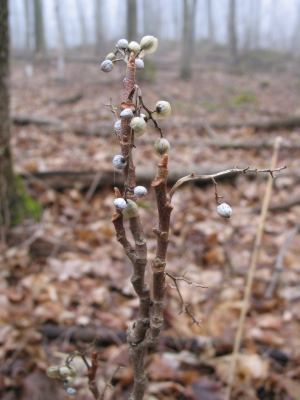
|
Here's a photo of Poison Ivy berries at the end of winter. They sometimes stay on the plant all
winter.
Note that there aren't really any other noticeable
identifying features at this time of year. Only some Poison Ivy
plants will retain berries through the winter. They fall off, and
birds eat them.
Yet it is said that the plant remains poisonous
even through the winter. However, the amount of oils in the plant at
that time is probably greatly reduced, and poisonings in this season
are rare.
|
|
|
|
|
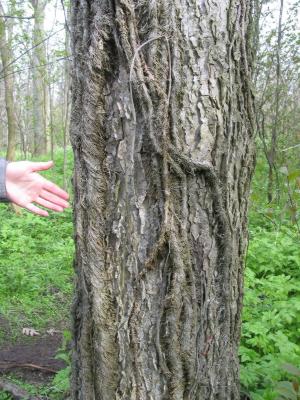
|
In more southerly areas
(southern Ontario and south) Poison Ivy becomes a vine and climbs
trees. It attaches to the tree with numerous fine rootlets. The tree
shown here has several Poison Ivy vines climbing it.
This picture was taken in the spring before any
leaves have come out, in Point Pelee National Park.
|
|
|
|
|
In the spring, when the leaves are fresh and
new, Poison Ivy is at its most potent.
Here's Poison Ivy in the spring, with fresh reddish
leaves just starting to come out. |
|
|
|
|
|
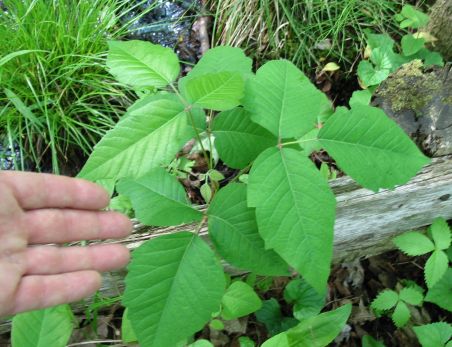
|
Poison Ivy in the summer. |
|
|
|
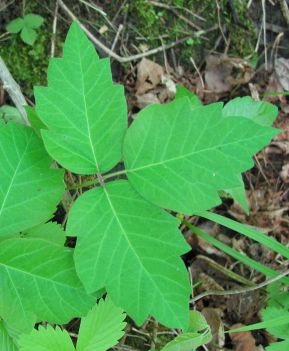 |
A closer look at the leaves.
Note that the leaves are sometimes toothed and
sometimes smooth-edged. |
|
|
|
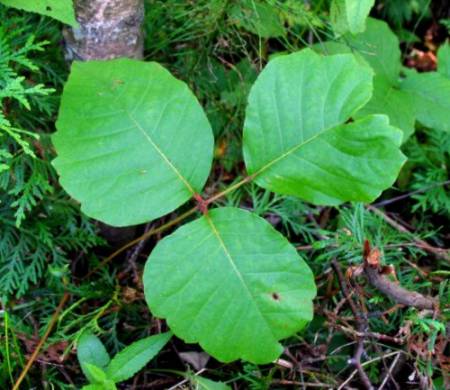 |
The leaves are variable, as shown by this photo. These leaves are
almost round! |
|
|
|
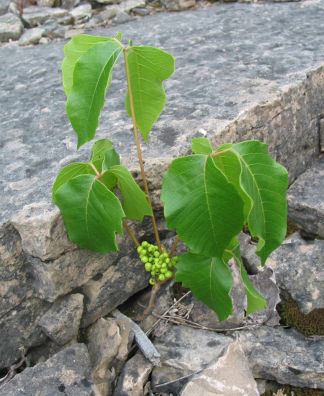 |
This plant is growing in a rocky area, a favourite
habitat of Poison Ivy.
Note the developing white berries.
Also note that this plant is growing in a very
different form that the one shown in the above two photos. This
plant's leaves are droopy, glossy, and fairly smooth-edged. The one
above has dull leaves, toothed edges, and aren't drooping. |
|
|
|
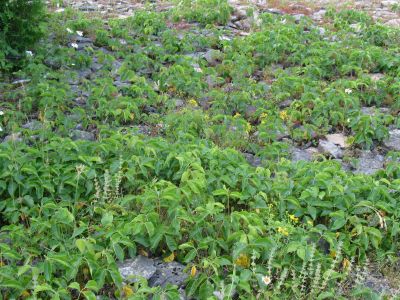 |
A colony of Poison Ivy in a rocky area.
It grows up from suckers it sends out, so it often
carpets a small area. |
|
|
|
|
|